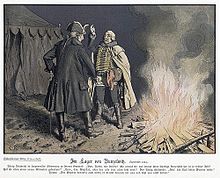Bolesławice (Jaworzyna Śląska)
| Bolesławice | ||
|---|---|---|
 Help on coat of arms |
|
|
| Basic data | ||
| State : | Poland | |
| Voivodeship : | Lower Silesia | |
| Powiat : | Świdnica | |
| Geographic location : | 50 ° 53 ' N , 16 ° 27' E | |
| Residents : | ||
| Telephone code : | (+48) 74 | |
| License plate : | DSW | |
| Economy and Transport | ||
| Street : | Świdnica - Jaworzyna Śląska | |
| Rail route : | Kamieniec Ząbkowicki – Jaworzyna Śląska | |
| Next international airport : | Wroclaw | |
Bolesławice ( de: Bunzelwitz ) is a place in the Gmina Jaworzyna Śląska ( King's tent ) in the powiat Świdnicki ( Schweidnitz ) in the Lower Silesian Voivodeship in Poland .
Geographical location
Bolesławice is located six kilometers northwest of the district town Świdnica ( Schweidnitz ). Neighboring towns are Nowice ( Neudorf ) and Żarów ( Würben ) in the north, Bożanów ( Eckersdorf ) and Wierzbna ( Würben ) in the northeast, Marcinowice ( Merzdorf ) in the east, Wilków ( Wilkau ) and Pszenno ( Weizenrodau ) in the southeast, Zawiszów ( Säbischdorf ) in the South, Witków ( Wickendorf ) in the southwest, Jaworów ( Jauernick ) in the west and Jaworzyna Śląska ( King's tent ) in the northwest.
history
Bunzelwitz was probably founded in the 13th century by the Counts of Würben , who are said to have been involved in the establishment of Schweidnitz and in the settlement of the area by Germans. The church of Bunzelwitz, attested for the year 1318, was at that time a branch of Würben.
Bunzelwitz belonged to the Duchy of Schweidnitz and fell to the Crown of Bohemia after the death of Duke Bolkos II in 1368 . In 1373 the former knight's seat Bunzelwitz was acquired by two Schweidnitz patrician families. In the 16th century Bunzelwitz became Protestant in the course of the Reformation . After the Thirty Years War , the church was returned to the Catholics in 1654.
After the First Silesian War , Bunzelwitz fell to Prussia in 1742, like almost all of Silesia . After the reorganization of Prussia, from 1815 it belonged to the province of Silesia and from 1816 was incorporated into the district of Schweidnitz , with which it remained connected until 1945. From 1874 Bunzelwitz belonged to the Königszelt district , in 1924 it was added to the Teichenau district. The manor of Bunzelwitz remained in the possession of the citizens of Schweidnitz until the 19th century. In 1939 Würben consisted of 627 residents.
As a result of the Second World War , Bunzelwitz fell to Poland together with almost all of Silesia in 1945 and was renamed Bolesławice . The German population was expelled. 1975-1998 Bolesławice belonged to the Wałbrzych Voivodeship ( Waldenburg ). This was dissolved with the administrative reform in 1999. Since then, Bolesławice has been part of the Lower Silesian Voivodeship.
Bunzelwitz camp
During the Seven Years' War the Prussian King Friedrich II set up an entrenched camp near Bunzelwitz with 50,000 soldiers against 132,000 soldiers of the allied Austrians and Russians, which went down in history as the Bunzelwitz camp . The king himself lived in a small farmhouse in Bunzelwitz from August 20th to 25th and September 10th to 25th. In the meantime he slept in a tent on the edge of the forest in Peterwitz . When a transshipment station was built there in the course of the railway construction from Wroclaw to Freiburg , around which a settlement developed, it was given the place name Königszelt , today Jaworzyna Śląska .
In the field camp of Bunzelwitz Friedrich received a Turkish ambassador in 1761 and concluded a military alliance with the Ottoman Empire directed against Austria and Russia , which, however, no longer came into effect before Russia changed sides .
Attractions
- The church of St. Hedwig, first mentioned in 1318, was expanded at the beginning of the 16th century.
- Bunzelwitz Castle was built in the Baroque style in 1783 and modernized in 1880. It is a two-storey rectangular building with a mansard hipped roof. South of the castle is a former manor with a baroque gate.
literature
- Hugo Weczerka (Hrsg.): Handbook of the historical places . Volume: Silesia (= Kröner's pocket edition . Volume 316). Kröner, Stuttgart 1977, ISBN 3-520-31601-3 , pp. 62-63.
- Dehio Handbook of Art Monuments in Poland Silesia . Munich and Berlin 2005, ISBN 3-422-03109-X , pp. 150–151.
Web links
Individual evidence
- ↑ http://territorial.de/ndschles/schweidn/gem1908w.htm
- ↑ http://territorial.de/ndschles/schweidn/teichena.htm
- ↑ PLOETZ Great Illustrated World History in 8 Volumes , Volume 6 (The non-European world until 1945), page 96. Ploetz Publishing House, Freiburg / Würzburg 1994

